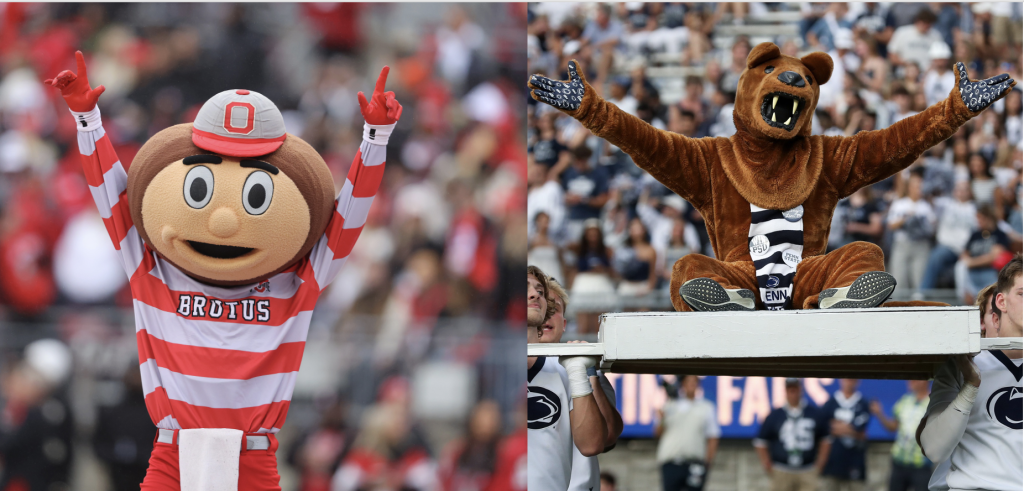On Saturday, the moribund Penn State Nittany Lions, already down a head coach, played the No. 1 ranked Ohio State Buckeyes on Fox’s Big Noon Saturday. Generally, Penn State-Ohio State is one of the highlights on the Big Ten schedule. Most years, it’s two blue-blood programs facing off with postseason and conference championship implications.
So when the two teams played last weekend, it was an interesting case study into the importance of “brand” in college football. Despite a dreadful season on the field, Penn State is still a national brand. Moreover, the Nittany Lions and Buckeyes have played at similar parts of the season on Big Noon Saturday each of the last three years, making for some surprisingly consistent comparisons. Two of those years, both teams were playing for stakes. This season, not so much, at least for Penn State.
That’s why it was a bit of a surprise when Fox announced that 7.2 million viewers tuned in for Saturday’s rout. The game handily beat out a neck-and-neck top-15 matchup between Texas and Vanderbilt on ABC in the same window, which drew just 4.5 million viewers. Throughout this season, ABC has won about half of the noon ET windows despite Fox scheduling its best game during the time slot, so it’s not as if viewers were simply tuned into Fox out of habit. They were on Fox because they wanted to see the big name programs.
We’ve written plenty this season about how brands really matter in college football. It’s one of the primary factors that has driven ABC and its SEC package to viewership dominance throughout the season. This past weekend, Fox got to capitalize on its brands. Penn State-Ohio State feels like a big game, even if it isn’t. Contrarily, Vanderbilt-Texas, despite having Texas, doesn’t feel like must-see TV. The fact that the former finished 38-14 and the latter finished 34-31 didn’t matter. Nearly three million more people watched the blowout with the big brands.
So let’s dig a little further and take a look at how Penn State-Ohio State fared the previous two seasons, when both teams were good. Last year’s game clocked in at 9.94 million viewers in the noon ET window on Fox the very same weekend this year’s game was played, meaning the difference in audience between last season and this season is about 2.7 million viewers. The competition that day was a bit weaker, with ABC airing Duke-Miami in the window (1.96 million viewers) and ESPN showing Arkansas-Ole Miss (1.18 million viewers).
In 2023, Penn State-Ohio State averaged 9.96 million viewers in late October, again on Fox’s Big Noon Saturday. The noon ET window was similarly weak that year as well. ABC aired UCF-Oklahoma (2.17 million viewers) and ESPN aired Mississippi State-Arkansas (1.22 million viewers).
So to recap, Penn State-Ohio State games when both teams are good and are also facing weak competition on other networks draw about 10 million viewers, while the same game this season averaged 7.2 million viewers in a blowout where one team’s season is already over, and other networks had good games. In spite of this, Saturday’s audience of 7.2 million is still good for the 15th most-watched game of the year so far.
It’s one small data point that supports what most people can likely sense about college football fans just by spending a few minutes on social media. Often, it’s not the quality of the game that’s important. It’s the quality of the brands. Penn State and Ohio State are two quality brands. Vanderbilt is not.
The same phenomenon was at play earlier this year when Indiana-Oregon, the clear game of the week, was only the fourth most-watched game that Saturday. People want to watch the brands that are familiar, with histories they know. Even if Vanderbilt is a good team, most people aren’t all that interested in whether they win or lose.
That’s why, even in a down year for the Penn State-Ohio State matchup, it retained the majority of its viewers from prior years and easily won its time slot.
(Yes, it probably helped that YouTube TV subscribers couldn’t get the ABC game, but that’s a story for another post, and likely only impacted viewership on the margins.)
Perhaps the past weekend will prove to be a lesson for the network executives that decide on the college football schedule. It’s obvious, but the biggest brands deliver the biggest audiences, even when those brands aren’t doing so hot on the field.
